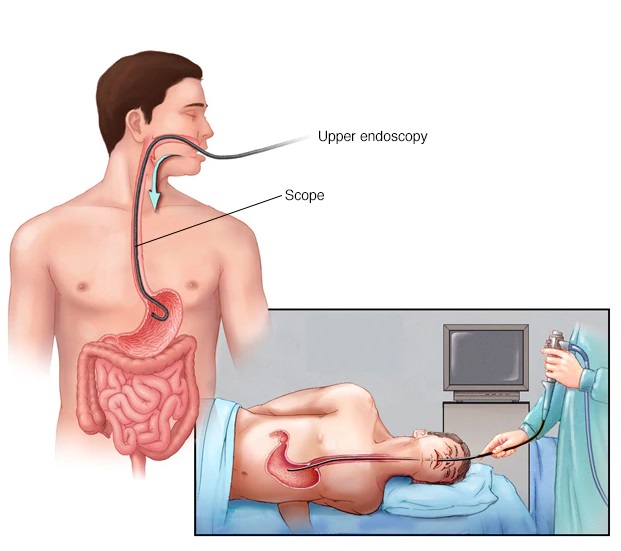Upper Gastrointestinal Endoscopy
- Home
- Upper Gastrointestinal Endoscopy
What is Upper Gastrointestinal Endoscopy?
It is a special procedure which allows the doctor to see the lining on the inside of food pipe, stomach and duodenum (the first part of small intestine.)
Why does one need this test?
Following symptoms or signs would make your doctor request this test:
-Unexplained pain in the upper belly
-To assess for reflux
-To assess symptoms of nausea and vomiting
-Chronic diarrhoea (usually more than 3 months duration)
-To investigate blood in vomit or black stools
-To investigate painful swallowing or symptoms food sticking in the gullet
-As a test to look for reasons that may lead to some abnormalities in other tests (eg. Anaemia, Growth on CT scan)
-To remove undesirable objects that may have been inadvertently swallowed

Procedure:
This examination would require preparation by fasting for 6 hours (usually overnight) and also certain medications being taken may need to be stopped (like blood thinners) prior to the test in some cases. If you are a diabetic then some further instructions may be necessary. Please discuss with your Physician or Endoscopist/Gastroenterologist if there are any concerns or questions.
After a consent is obtained the patient is taken to the endoscopy room. Usually sedation is not necessary for this examination but if any concerns the patient should discuss with the Endoscopist/Physician/Gastroenterologist. A local anaesthetic may be offered in the form of a throat spray which can numb the throat and reduce the gag reflex. Many Endoscopists don’t use this as well and if there are any concerns please do not hesitate to discuss with the doctor or the nurse.
A mouth guard is used to keep the mouth open for the examination and a thin tube with a camera at the end is introduced through the mouth into the gullet and stomach and the first part of the small intestine – Duodenum. This would help identify the cause of any symptoms that necessitated the test.
The Endoscopist may also do a test called biopsy which involves taking small piece of tissue from the lining of digestive tract and this is not felt by the patient. The biopsy will be sent to the laboratory to check it under a microscope. The doctor may also need to do other things like removing a growth, give injections or apply bands to stop bleeding or dilate the passage if necessary.
After the results have been explained by the Physician/Gastroenterologist, the patient is allowed home. However, in case sedation has been given or an extra procedure has been performed (eg. Dilatation of the tract), the patient is advised to stay for observation for 2 hours or so.
-Bloating and pain is the most common side effect post procedure but bloated hard belly may need assessment so the Endoscopist or Physician should be contacted if these symptoms persists
-Nausea
-Food from stomach getting into the lungs
-Bleeding (usually when another procedure has been performed)
-Tear in the digestive tract lining
-In case sedation is used one can get redness around the site where the needle was inserted
Please contact the doctor if a patient suffers with persistent pain with swallowing, vomiting, black stools or fever.
Available at:
(with prior appointment please)
